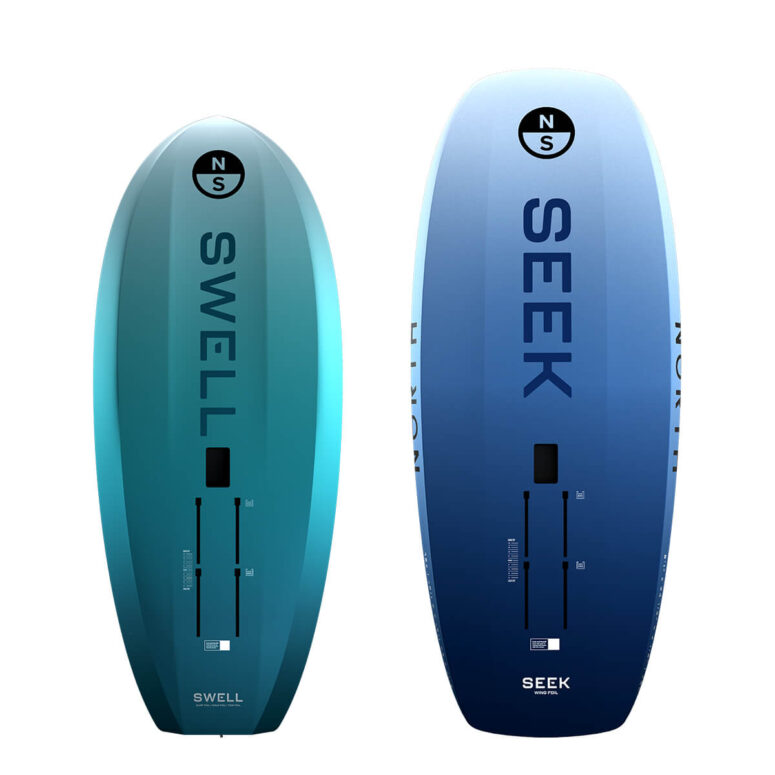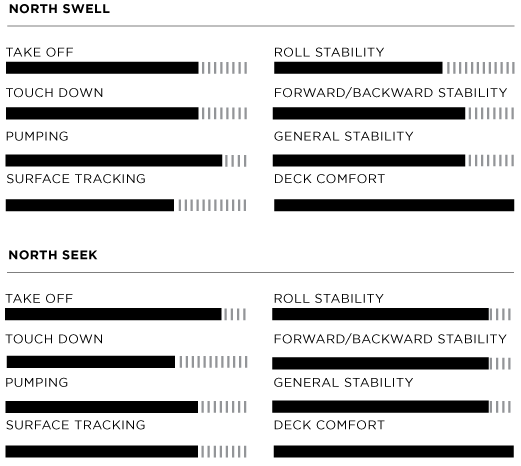

When you purchase gear through links on our site, we may earn a small commission. Here’s why you can trust our tests and our affiliate partner.

For 2025 the Swell, which was previously a crossover prone surfboard from the North range, takes on some new larger sizes to give it a wider wingfoil application, as the shape lends itself to performance wave riding. The size range now stretches from 35l through to 85l in 10 liter increments. It was immediately obvious from the 65l we tested that the shape has changed considerably from last year. It’s now sporting an emphasized teardrop outline, with most of the volume concentrated three quarters of the way up the board under your chest or front foot, this board being a fairly wide 24” at maximum width. The remainder of the board, particularly the tail, runs back to be relatively narrow, with a hint of downwind board design influence with the sharp 90 degree cutoff. This runs up to a purposeful more surf-inspired nose area which is sharp enough to penetrate an oncoming wave if necessary or bounce nicely off a whitewater section. A gentle single tunnel concave runs through the nose in the first third of the board, and we felt this aided tracking and touchdowns without compromising ease of release too much. At no point did it feel like it was sucking to the water, and it was always eager to release.
The Swell we tested in two interesting contexts, firstly as a sub-30 liters sinker in performance surf, and secondly as a neutral bodyweight, partial floater with my wife as a progressive intermediate. As a sinker in bigger surf and choppier hell conditions we were glad of the nose width for an easy strapless knee start; the volume is concentrated around where you need it when it comes to the crunch, and it surfaces and takes off without excessive wing power required, far more manageable than a narrow mid length of equivalent volume for instance. It feels lively enough underfoot and the narrow tail of the board, and chine of the rails in the wide front-foot section, means it isn’t likely to catch a rail during more aggressive turning on the face. In a neutral bodyweight context, we found the board’s early lift characteristics impressive, and it garnered an impressive amount of surface stability considering the more surf-focused outline and made a great daily driver for a 65kg rider wanting to step down from full displacement, giving an increase in agility but not sacrificing a secure feeling, particularly in offshore conditions.
The Seek slots in neatly to the range with its squarer outline, catering for complete beginners down to progressive freestylers, in sizing from 58l through to a colossal 138l, in eight increments spaced at 10l. This is probably one of the most comprehensive range of sizes from one board model we’ve seen on the market and speaks legend about the range of application North have in mind for it. The hull shape is extremely clean and simple, with another 90 degree cutoff tail and a little less entry rocker than the Swell in the nose. In practice, the square outline gives a very surface-stable craft with four points of stability and fairly even volume distribution. A little kick in the nose helps it plough over surface chop well and avoid pearling if you’re heavy footed. The rail bevel is most amplified in the wider mid-section of the board, which makes perfect logical sense, as this is where you’re most likely to contact. In practice, the Seek is a novice rider’s dream, feeling exceptionally stable on the surface where other brands have perhaps gone narrower and more tippy. It allows the rider to line up wing and board angle without much of a fight for balance and progress extremely quickly. What’s not been sacrificed is an effortless takeoff; the simple clean release bottom shape is relatively easy to release as a stable full displacement board goes, without requiring an excessive amount of power in the wing. The slap when touching down has been mitigated by a subtle concave in the nose. Perhaps what’s undersold is using the smaller sizes as a sinker for freestyle, where a hard landing from a technical trick may be rescued by some evenly placed volume and square outline, a tactic we’re seeing employed regularly in recent competition.
The deck pads on both boards are definitely worth mentioning, they are thin and grippy and translate the foil feeling well. They cover a massive area of the top surface of the board all the way up to the rail edge, so if you do misplace a foot here and there there’s a good chance you’ll rescue it, couple this with a light concave into the deck and you feel planted and secure, and it’s amazing how important this is when in a tight spot. There’s some color coding to each section of EVA which also helps demark the center foil box in the rear section and a kick pad. Inserts on both boards cater for both an inline down the stringer setup as well and a V formation, with plenty of options for fore and aft balance. We found both boards well-trimmed for a relatively central foil placement with the North foil range as you’d expect, but enough length in the tracks for a little trimming room if (heaven forbid) you are crossing into other brands’ foils. Gore-Tex vents are present to help these boards breath if necessary.
North’s extended drop box design carries onto all their boards this year which is a practical solution, letting you leave the nuts and bolts attached to the foil and preventing fumbling lost nuts in the sand. Both boards also sport a deep carry handle on the base in front of the foil box which is well balanced with a foil on, something worth considering if you’ve got a long walk in. Both boards come in at a very competitive price point for a robust hybrid carbon build.
So who should choose which? In this instance it’s crystal clear. A more advanced surf-focused rider will benefit from the narrower tail and lower volume options of the Swell, not to mention the prone and tow crossover potential. The Seek will suit complete beginners who want a high level of surface stability in displacement mode, and also those perhaps dipping under their bodyweight who want a very practical sinker. Both boards in face have a general feeling of practicality and ease about them, making riding tougher conditions all the more appealing.
